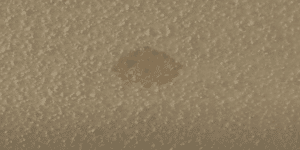It is tough to sit calmly when you have water stains on ceiling, especially if it’s a recently renovated house. These dreaded stains destroy all the efforts you put into improving the interior charm of the property.

This issue has annoyed me for a long time. There must be an effective solution to resolve this issue once and for all! I did extensive research and now sharing some important facts to help you in coping with this issue.
Those ugly water stains appear on the ceiling due to moisture. The moisture can leak through the roof and also from the upstairs bathroom. Whatever the source is, it is decaying ceiling paint. You won’t sit calmly until you fix the problem if you like to live in a clean and healthy environment.
So, who should you call and how to fix this problem? Is a simple paint job enough to fix this issue? All these questions will tickle in your brain. Even though it’s a resolvable issue, it can cause unnecessary stress. I have faced that trouble and now I am going to share some effective solutions. Continue reading this post to know how to prevent water stains on ceiling.
How to remove water stain from ceiling without painting?
Most of the homeowners decide to paint their walls and ceiling when they spot water stains. Is it the right solution? No, painting is expensive and time-consuming. You will have to vacate the entire room to paint the stained ceiling again. Do not waste your time and money, when some affordable fixes are available.
Learn how to remove water stain from ceiling without painting and solve the problem on your own. Do not forget to fix the source of moisture before you try the following methods!
Method 1: Oxygen Bleach
- Cover the entire floor and put on your safety goggles and face mask.
- Blend warm water and oxygen bleach in a bucket in equal quantities.
- Now, soak a sponge in this solution and use it to wipe the stain.
- Continue wiping until the stain is completely removed.
- Wipe the stained area with clean water and the job is done!
Method 2: Distilled Vinegar
- Distilled vinegar can quickly remove marks left by deposited minerals. So, blend this ingredient with water in equal quantities.
- Soak a sponge in this solution and then rub water stains with that sponge.
- Let the applied solution sit for 3-5 minutes.
- Rub the stain again with a distilled vinegar solution in a circular motion.
- The stain will vanish and you can rinse the affected area with clean water.
- Wipe the spot with a clean towel and the job is done!
Water stains on ceiling removal
My home’s ceiling is painted in white color. Therefore, it looks quite dirty when stains and blemishes occur on the ceiling. Methods explained in this post work perfectly to remove dirty brown stains, but these spots will reappear in new areas. Therefore, it is important to understand the root causes of water stains for permanent water stains on ceiling removal.
Water stains occur in the ceiling due to:
- Leaking water pipe in the ceiling and walls
- Water leakage in HVAC unit
- Poorly installed HVAC unit
- Roof flashing failure
- Aged waterproofing membrane
If you don’t find the leak, call a plumber or contractor to diagnose the root cause. I applied a quick solution to save my time and money. You can also do the same if you follow my guide for water stains on ceiling removal.
How to fix water stains on ceiling
Follow the below-explained steps to learn how to fix water stains on ceiling:
- Recognize the root cause of the issue:
You have just learned what causes ugly brown stains in the roof. So, don’t waste your time anymore. Start looking at the cause of moisture in the roof. Compromised waterproofing membrane, crumbling shingles, and poor seals across roof vents can cause this problem. It’s time to replace caulking if the water is leaking through the upstairs bathroom. Repair the leakage to prevent future issues.
- Clean water stains with bleach:
Move to this step when the underlying problem is solved. So, now is the time to get rid of the stain without repainting the ceiling. You need the following things to clean water stain perfectly:
- Bleach
- Warm water
- A spray bottle
- A sponge
- Safety goggles, face mask, a hard hat
- Blend 1-cup bleach in 3-cup quantity of warm water.
- Pour the cleaning solution in a spray bottle.
- Use a ladder or chair to reach the ceiling and spray the cleaning solution directly on brown water stains.
- Wait for a minute and dab that stain gently with a sponge.
- Keep applying the bleach and keep dabbing until you remove the stain.
Magic Eraser water stains ceiling
Millions of people have chosen the Magic Eraser water stains ceiling method to get rid of tough brown water stains. I had first applied the bleach method, but bleach released nasty fumes. Therefore, I don’t recommend the first method.
The Mr Clean Magic Eraser is a remarkable cleaning tool. You don’t need bleach or other cleaning agents to remove ceiling water stains. Magic Eraser alone is capable of removing tough brown stains without damaging ceiling paint. Follow the below-given tips if you use Magic Eraser to clean water stains on ceiling.
- Dip your Magic Eraser in clean water.
- Squeeze excess water.
- Rub tough with the eraser.
- Follow a gentle approach and stains will vanish in one or two attempts.
Condensation stains on the ceiling
This is actually a very common problem, but you should not ignore it. Address it as soon as possible to prevent serious damage. You may see black spots on the ceiling if you don’t fix this issue. Condensation stains on the ceiling are mold build-up that occurs due to moisture and it can spread across the ceiling. The cold wall can result in a very similar problem. You can fix it and prevent it in the future.
The main cause of ceiling moisture:
It usually occurs due to poorly insulated and ventilated space above the ceiling. Heat gets trapped above the ceiling and it frequently warms the ceiling. So, when you turn on the AC or natural cool air rises up and comes in contact with the heated ceiling, then this problem occurs.
This problem mainly occurs in the rainy season and the winter season. You heat the interior and that heat gets trapped. Natural cool air contacts that heat and causes condensation. You have to maintain proper ventilation in the attic to prevent it.
How to fix this problem?
You have to apply a three-step solution to prevent wet ceiling.
- Install a rigid vent:
- Insulate the attic:
- Reduce humidity levels in your home:
How to Paint Over Water Stains on the Ceiling?
As described several times before, water leakage is the biggest cause of ceiling water stains. Paintwork won’t last too long if you don’t fix the water leakage solution. Follow a step-by-step guide to learn how to paint over water stains on the ceiling. This method is quite effective against the ceiling water stain issue.[/su_note]
- Fix the water leakage:
- Test the drywall:
- Use the stain-blocking primer:
- Repaint the target area:
How to cover water stains on ceiling?
Try the following steps to learn how to cover water stains on ceiling:
- Empty the entire room or cover the furniture and other expensive things with a plastic sheet.
- Scour the entire ceiling to remove dust and spider webs (if there are any).
- Remove lose paint flakes.
- Use diluted bleach to clean water stains.
- Let the ceiling dry and then apply a thin coating of stain-sealing primer.
- Wait until the primer dries and then paint the primed spots.
- Let the first coat dry and then apply another coat.
That’s how to cover water stains on ceiling. If you don’t have a reliable stain-blocking primer, then buy the KILZ Original Multi-Surface Stain Blocking Interior Oil-Based Primer/Sealer.
- Being one of the top-rated primers, the KILZ Original Multi-Surface Stain Blocking primer can block smoke, water, tannin, pencil, ink, and grease stains. It also makes the paint stick better. Use this primer on the entire ceiling and then repaint it. There won’t be any stain on your ceiling for many years!
How to remove water stain from wall
Ceiling water leakage is quite harmful for your home’s interior. It can also cause mold build-up and dark water stains on the walls. Use the below given method to learn how to remove water stains from wall:
- Blend 1-cup bleach into 3-cup quantity of water and pour this cleaning solution in a spray bottle.
- Spray this cleaning solution directly on wall stains.
- Rub walls stains with a sponge and continue apply diluted bleach mixture.
- Rub or dab water stains on the wall and those stains will vanish within 10-15 minutes.
What if there are water spots on ceiling but no leak?
If there are water spots on ceiling but no leak, such stains occur due to mold and mildew build-up. There will be musky smell and it’s a sign that ceiling stains are occurring due to mold.
This problem can also occur due to cracked window, toilet above the ceiling, unknown plumbing damage, and water condensation. You can easily fix this problem if you follow the below-explained method.
- Identify the moisture source and block it.
- Clean dirty stain patches.
- Use two coats of stain-blocking primer.
- Repaint the affected area to make the ceiling look attractive again.
This is how you can fix the problem if there are water spots on ceiling but no leak.
Q&A
What does a water stain on the ceiling mean?
If there are stains on the ceiling, it means water is seeping through the ceiling material. It can damage the ceiling if you don’t find and repair the leak quickly.
Can you just paint over water damage?
Yes, you can paint over water damage but that paintwork won’t last more than a few days. Do not waste your money in this way. Find the root cause of water damage, fix it, let the ceiling or wall dry, and then paint.
How can you tell if a ceiling has water damage?
There will be brown or dark black stains on the ceiling. Mold and mildew build-up is another sign that your ceiling has water damage.
How long does it take for a ceiling to dry after a leak?
It takes 48-72 hours for a ceiling to dry. It may take a much longer time if you can prevent humid air from entering your house.
Does water stain ceiling mean mold?
No, water stain does not mean mold but it can be mold and mildew build-up due to moisture! Mold produces a musty smell. It is a sign that mold is forming in the ceiling and you should remove it as soon as possible to maintain proper hygiene in the house.
Conclusion:
A dirty and stained ceiling is a sign that you do not pay attention to the maintenance needs of your property. Do not let people presume that. Use the information shared in this post to treat water stains on ceiling. These solutions will also help you in prevent such issues in the future.
